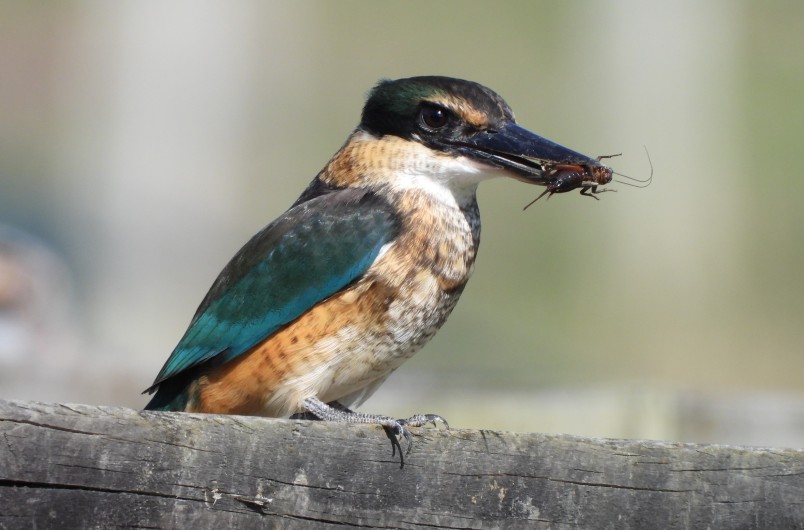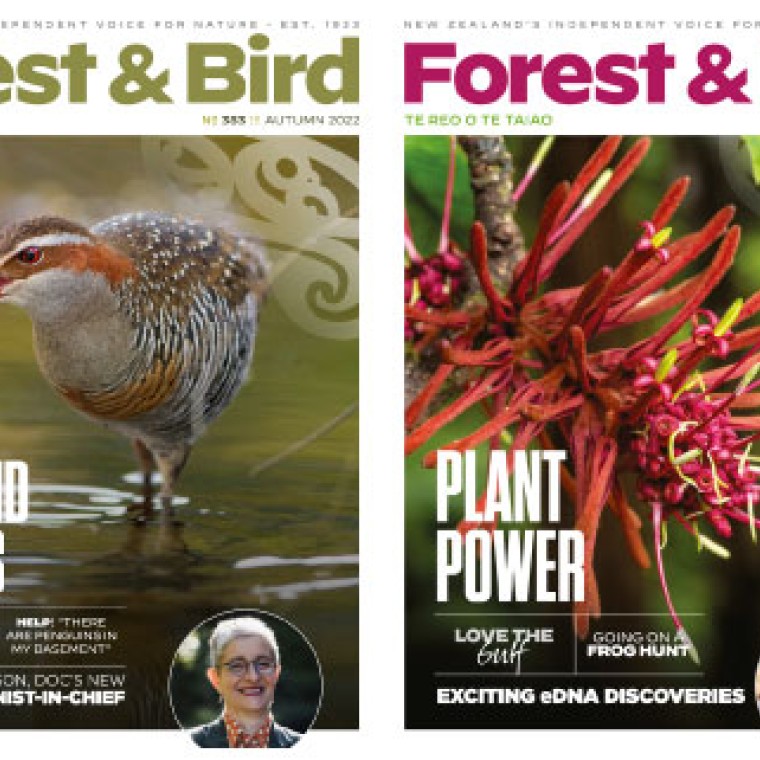Encouraging insects and other critters to your urban garden is key to creating a healthy habitat for birds, lizards, and other native wildlife. By Geraldine Canham-Harvey
Forest & Bird magazine
A version of this story was first published in the Autumn 2025 issue of Forest & Bird magazine.
Would you like your garden to be welcoming to our native wildlife? Would you, your whānau, or flatmates like to see tūī, pīwakawaka fantail, tauhou waxeye, or kōtare kingfisher fly in and hang out in your yard?
There are many ways to put out the welcome mat to native birds. Providing sources of food is a given, as are natural habitats to roost and hide in, most typically trees and shrubs.
However, the best way to attract the birds into your garden is to make it biodiverse, meaning it supports a variety of life. Think of your garden as an ecosystem – because it is or can be.
Yolanda van Heezik, professor of zoology at the University of Otago, says invertebrates are super important when it comes to attracting birds into urban gardens.

Yolanda van Heezik. Image: supplied.
“Overseas studies show that, when urban bird populations aren’t doing well, it’s often because there aren’t sufficient numbers of invertebrates in the area,” she said.
“However, if we can provide enough of the right kind of invertebrate-friendly vegetation – the kind of plants they need for a safe habitat and to provide plenty of food – they will come back.”
It’s not hard to create a biodiverse garden if you’re willing to make it attractive to a wide range of critters – insects, spiders, centipedes and millipedes, worms, snails, and slugs.
As well as pollinating bees and butterflies, we also need ladybugs and spiders that feed on what we humans consider “pest” insects, such as aphids and wasps.
For many native birds, invertebrates are an important food source. Pīwakawaka, along with many other native birds, are omnivores, eating both plants and animals. You might be familiar with fantails following you in the bush to pick off the flying insects disturbed as you walk.
Other examples include nectar drinkers, such as tūī and korimako bellbird, who will hunt insects to provide protein to their young. For carnivorous native birds, such as kōtare kingfisher or ruru morepork, insects are also an important part of their diet.
But our gardens can be unfriendly places for insects to hang out.
"Think of your garden as an ecosystem – because it is or can be."
Some of our garden practices, including having immaculately manicured lawns or using pesticides and herbicides, are squeezing the wild out of our gardens and, according to the experts, may lead to fewer birds in our cities and towns.
The good news is that there are lots of things we can do to attract more insects to the garden.
Insect behavioural expert Dr Jenny Jandt, of University of Otago, has created a home garden teeming with insects and other invertebrates in Ōtepoti Dunedin.
“To attract and keep insects and other invertebrates in your garden, you just need to have the right pieces in place to really maximise the habitat, to make it as attractive as possible for them,” she said.
“In turn, that maximises the chances of birds returning too. Once the native birds discovered my garden, I found they were sticking around because they’ve got all of these other natural food sources to eat, lots of bugs to eat.”
It’s possible to add a bit of wild to any urban garden – large or small – all you need to do is offer native species the right kind of habitats for them to live, eat, and hide in.
Fortunately, this is simple and can take little effort – you might even find you save time and money, compared to how you garden now. Importantly, you don’t need to tear up your garden or stop using it for relaxation, socialising, or kicking the ball around the back with the kids.

Kōtare in a Whanganui garden. Image: Johanna Taylor
Jenny says you can begin with what you have, start small, maybe in one particular area of the garden, and see what happens. As well as birds, you may find skinks, geckos, and even bats might also move in.
Another benefit of increasing insect and bird populations in your garden is the pollination of backyard vegetables and fruits.
Jenny explains that, if you have flowers blooming in your garden all year around, then the pollinators will start coming early and often, and keep coming. This means they will be around in your garden when your crops start to bloom and need pollinating.
Biodiverse gardens can look a bit messy and neglected to some, but there are ways you can signal deliberate intention to the look of a wildlife garden.
For instance, mowing paths through (or edges around) it or intentionally planting flowers as a border. These provide obvious cues that the garden is cared for and not neglected.

Monarch butterfly. Image: Sally Phillips
Despite this, social norms about what a skilled gardener’s garden should look like can come to the fore, and you may find yourself engaged in conversations with neighbours about what you are doing and why.
Herein lies another wellbeing benefit of wildlife gardening: the potential for human connection. Talking to people about why you are designing and managing a wildlife garden can both inform but also potentially inspire others to follow suit.
The health benefits for wild gardening + how to create a wildlife-friendly garden, see below.
Dig for the future
Wild gardening is good for people too. By Geraldine Canham-Harvey

Jenny Jandt in her garden. Image: supplied
Studies have shown numerous mental health benefits of wildlife gardening, such as the joy of experiencing nature close to home and surprise encounters with birds and lizards.
Being in nature is relaxing and mood-enhancing, and we can boost these feelings by practising wildlife gardening, knowing our mahi is also helping protect native species from local (or national) extinction.
There are other benefits too – the chance to be creative, providing pretty places in your garden as you experiment with new kinds of native plants and flowers. Plus there’s the enjoyment of sharing the results of your hard work with friends, whānau, and neighbours.
Gardening can foster social connections too. For example, residents in a townhouse development might work together to create mini native habitats as stepping stones for urban wildlife, such as bees and butterflies, to move through and pollinate flowers throughout the neighbourhood.
Yolanda van Heezik says creating more biodiverse living environments is a win–win for gardeners as they boost our physical and mental wellbeing while also helping the planet.
“We can be protecting biodiversity, contributing to mitigating against the impacts of climate change, and helping our community adapt to our warming world,” she said.
Gardening is gaining recognition “as critical to enhancing and conserving urban biodiversity”, according to a recent study published by Andreas Samus et al in New Zealand in 2023.
Your backyard could play its part in this – and you would also reap the personal benefits, along with the native wildlife.
Geraldine Canham-Harvey is Forest & Bird’s Kiwi Conservation Club administrator. This article was inspired by a science communication project she recently completed at Victoria University of Wellington. References available on request.
Wild garden tips
Creating critter-and-climate friendly backyards in New Zealand.

A wild Dunedin garden. Image: supplied
THINK LIKE A LOCAL: Native insects feed on specific native plants, as do some native birds. Try kōwhai, hebe, harakeke, mānuka, and pōhutukawa to keep local critters happy.
SPICE ME UP: Choose trees and plants that fruit and flower through different times of the year – they don’t all have to be native plants.
CROWD PLEASERS: Plant fruit trees to give flowers for bees and birds in spring and fruit for humans in summer/ autumn.
LOOK UP: Try growing plants up trellises or trees. New Zealand’s native white flowering clematis is spectacular in spring.
GO POTTY: Native plants can be grown in pots too – hanging baskets of native creeping fuchsia will provide colourful flowers and berries.
PLANT VARIETY: Grow kawakawa, dwarf mānuka, kōwhai, or harakeke flax in pots or garden beds to attract insects who will love dining on their leaves or flowers.
LAYER UP: Critters need an “understorey cover” to hide in. Have plants growing under taller plants and trees, to provide safe spaces.
BEE HAPPY: Native bees often nest in the ground and appreciate some bare soil or clay.
GO LOW: Groundcover plants provide hiding places. Some, such as pōhueuhue, will attract certain kinds of insects and native lizards.
SAFE SPACES: Build piles of logs or rocks to create habitats or hang up an “insect hotel”. Garden ornaments can also provide hiding places.
NO SWEAT: Leave fallen branches and leaves to rot on the ground to provide food, nutrients, and cool, dark hiding places.
KEEP ‘EM SAFE: Avoid using pesticides and insecticides anywhere near where you intend to put out the welcome mat for invertebrates and birds.
LESS LABOUR: If you’re really keen, don’t mow the lawn – long grasses provide habitats for multitudes of invertebrates.
Check out insect behaviouralist Dr Jenny Jandt’s website jandtlab.com for more wild gardening advice and inspiration.

